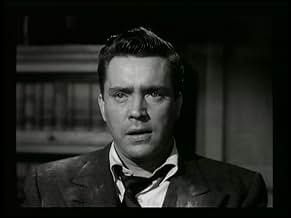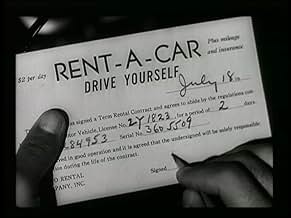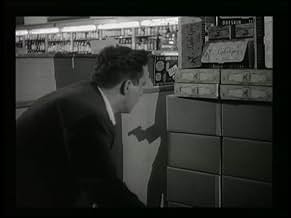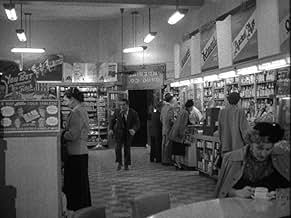Frank Bigelow, qui apprend qu'il a été empoisonné et qu'il ne lui reste que quelques jours à vivre, tente de découvrir qui l'a tué et pourquoi..Frank Bigelow, qui apprend qu'il a été empoisonné et qu'il ne lui reste que quelques jours à vivre, tente de découvrir qui l'a tué et pourquoi..Frank Bigelow, qui apprend qu'il a été empoisonné et qu'il ne lui reste que quelques jours à vivre, tente de découvrir qui l'a tué et pourquoi..
- Réalisation
- Scénario
- Casting principal
- Récompenses
- 2 victoires au total
- Miss Foster
- (as Beverly Campbell)
- Sue
- (as Cay Forrester)
- Dr. Matson
- (as Fred Jaquet)
- Dr. Schaefer
- (as Larry Dobkin)
- St. Francis Hotel Desk Clerk
- (non crédité)
Avis à la une
It must be the dream of all directors to open a film with a scene or line which carries great impact and remains in the memory. The opening line in D.O.A must rank among the most dramatically effective and intriguing lines that has ever opened a movie. This is the quintessential film noir. Edmond O'Brien as the tough, hard drinking businessman who has grown tired of the normalcy of his life and the clinging Paula. His holiday in San Francisco is an opportunity to break the shackels. The premise that the hero has been given a slow poison for which there is no cure, and only a day or so to solve his own murder before he dies, is exceptional. We also have an array of sultry "bad girls", a seedy villain and a manic hitman. Rudoph Mate directs brilliantly, not missing a moment to twist and turn the action at a fast pace with no dull moments. Scenes of O'Brien running through city streets after he has learned his fate are superb with incredibly realistic wide shots. The fact that his direction is so effective makes one wonder how he could have allowed the lapses of ridiculous canned "wolf whistles" whenever the hero passed a good looking girl in the early scenes. Although these "wolf whistles" are really out of place and very annoying, the film is so effective that we can forgive the indiscretion. This is a classic example of a brilliant plot superbly told in a way that is still gripping 50 years after it was made. D.O.A. defines Film Noir.
It starts with a bang, O'Brien staggering into the local homicide unit to tell the cops that there's been a murder - his, before launching into the massive flash-back which takes up pretty much the rest of the movie. The action from there on is hectic and as convoluted as all the best noirs are as O'Brien, infected by a deadly poison, races against the clock to track down his own killer and the reason behind it.
The film makes fine use of actual San Francisco and Los Angeles locations as well as authentically depicting the hot and steamy atmosphere at a Frisco jazz club. O'Brien is great as the doomed Bigelow, racing, often literally, against the clock, stopping only to palm off his adoring secretary girl-friend, Pamela Britten, who of course doesn't find out what's wrong with him until too late.
The pacing is almost non-stop once it gathers momentum, unfortunately when it does, some of the scene-writing gets over-ripe and correspondingly over-acted as O'Brien and his girl pour out their hearts somewhat unnecessarily. The film ends bravely though with a downbeat conclusion, delivering what the title says it must and at least tying up all the loose ends by that time.
This memorable key scene portends his disconnection from those around him and represents a crack, however slight, in his life's foundation. Though initially reticent about socializing and imbibing with people he just met, he has unwittingly been thrust into a reality more threatening than is immediately apparent. Later in the film, a jarring example of his full blown isolation occurs when he finds himself in an outdoor, public area. In unbearable turmoil, he momentarily encounters a little girl innocently playing with a toy. She appears in soft lighting, contrasting starkly to the shadows surrounding Bigelow, whose face registers the painful shock of awareness that ordinary activity continues unabated even while he grapples with extreme danger. This is reinforced when seconds later he observes a young couple embracing, compounding his agonizing realization that all simple pleasures are now unattainable to him. Noticeably, when he is literally "up against the wall" his back is touching signage of "Life Magazine" logos. All that once comprised his own life, that which he had considered to be little more than mundane minutiae, is heightened in significance and irrevocably at stake.
This brings me to D.O.A., directed by Rudolf Maté. D.O.A. in my book is the Citizen Kane of the noirs. It's so good that I often wonder about how it got made in the first place. Since many of the people who were involved in its production are now no longer with us, I may never learn anything about its origins. That's a frustration, of course, but the more important thing is that I can recognize a great noir when I see it.
Why, you ask, is D.O.A. a great noir? The most obvious reason is its plot. A guy goes out for a night on the town and someone, a total stranger, slips him a mickey in a bar-a lethal mickey. But it doesn't kill him instantly. It kills him slowly, so slowly that he's given the chance to find out who did this terrible thing to him, and why.
Second, the film is exceptionally well made in every other respect. Okay, the Pamela Britton character is one dimensional and embarrassing, we all agree on that, but who really cares when everything else in the film is so good? Edmond O'Brien had one of the best roles of his career in D.O.A., and he took full advantage, though few critics give his performance much credit for the film's success.
O'Brien, a classically trained actor, plays a small-time Southern California businessman living his ordinary little life, minding his own business, regularly boffing his secretary (this was implied rather than made explicit; after all, this was 1949), and avoiding her whiney entreaties that they tie the knot, as he's been promising her he would do for ever so long.
You can't help liking O'Brien in part precisely because of his human flaws. He's basically decent, but harassed, overworked, and stretched to the limit by the pressure put on him by Britton. What adult male couldn't identify with this man, or at least sympathize? His very insignificance as one more human ant on the planet Earth, and the terrible thing that's about to happen to him, are the essence of great film noir. (Detour, although by no means a favorite noir of mine, is nevertheless another perfect example of an ordinary man, a small-timer, minding his own business and unexpectedly colliding with Fate and all that it has in store for him.) We resonate to D.O.A. because fate and contingency have been the fundamental conditions of life on the planet earth since before the beginning of history. Our time on Earth is brief and our lives but little scraps of paper blown about by the wind toward endings we know not. We live noir lives.
The film's particulars are wonderful. From the sunny hick town of Banning, the movie switches quickly to San Francisco. If ever there were a noir town, it's Frisco. (Hitchcock picked up on that real quick; watch Vertigo again to see how he saw the eerie side to that town, with its creepy deserted streets, little ghostlike fog-blown urban hills, and other abandoned places suggestive of loneliness and soullessness.)
From here one great noir scene follows another in astonishing succession: the smoky, crowded jazz bar where the sweaty black musicians are blowing up a storm (to an all-white 1949 audience of course), while a murder is silently committed with a switched drink. The doctor holding the eerily glowing glass tube of luminescent poison and informing O'Brien, "You've been murdered." O'Brien running through the crowded downtown streets like a madman, as if velocity could help him escape his fate. O'Brien, after being shot at, a gun now in his own hand, looking for his killer in the abandoned processing plant. His encounter with Luther Adler's insane, sadistic henchman played by Neville Brand. Brand, speaking softly, glints of spittle in the corners of his mouth, nutty little eyes lighting up with anticipated pleasure: "I'm gonna give it to you in the belly. You're soft in the belly, aren't'cha? " Then the fantastic night scene in the crowded Los Angeles drugstore with Brand stalking him among oblivious customers-till shots ring out, then screams, followed by death. Finally, again at night, O'Brien's confrontation with his killer, which (inevitably) occurs in the Bradbury Building, that great architectural shrine to noir, scene of so many other noir films.
Let's stop for a moment and go back to an earlier part of the film. Fatally poisoned, still not quite believing what has happened to him, exhausted and uncertain of anything, O'Brien has run for block after block, but now his energy has finally petered out and he finds himself alone near the docks. Utterly depleted, all hope lost, he wearily leans against the side of an old wooden newsstand in an otherwise bleak, abandoned area. Eyes glazing over, he's terrified, trying to catch his breath. During a medium close-up we briefly study him, then notice something to his left, a single long vertical row of magazines, all identical covers, arranged down the side of the kiosk just half a hand away from him. He isn't looking at them, isn't really aware of them, but we are. For just a few seconds we see: Life, Life, Life, Life, Life, Life, Life. Then the film quickly moves on and goes about its business, as if we had been shown nothing of importance.
You tell me this isn't a great film noir.
It's a story about how a simple act can lead to disaster in this case, death. If you've not seen it, I'm not about to tell you much except this: it has perhaps the most imaginative beginning for any murder mystery ever devised as Frank Bigelow (Edmond O'Brien) fronts up to the Homicide Bureau in Los Angeles to report a murder his own! Thereafter, the story traces Frank's attempts to find out who is trying to kill him, and why. One of the best pieces of irony is when, having learnt that he will die soon, Frank runs and runs until he's out of breath and stops, panting, beside a newsstand where there are multiple copies of Life magazine hanging there, just beside him. The director, Rudolph Mate, had a real insider joke with that shot.
And that long tracking shot, by the way, was an excellent example of how to use fast camera work and great editing.
On another level, the movie very much fits the times vis-à-vis the portrayal of evil and where it leads: retribution is always just around the corner for those who transgress society, even if you think you're justified. When you see this movie, you'll know what I mean.
And, for the times, the acting was good, with a standout performance from Edmond O'Brien, and ably supported by the ever-competent Luther Adler (as Majak, the sharp dealer in stolen goods), and Neville Brand, as the psychopathic Chester. The rest of the cast was adequate. The only jarring note (no pun intended) are the peculiar and bizarre wolf-whistles (inserted by some demented sound engineer?) that accompany Frank Bigelow as he looks at women in his hotel at San Francisco. What was the director thinking of...?
That aside, it's a good, fast-paced action mystery that helped to keep the film noir genre very much alive. Have a go...
Le saviez-vous
- AnecdotesThe scene in which Bigelow runs in panic through the streets after learning he has been poisoned was what is considered a 'stolen shot' where the pedestrians along the sidewalk had no idea a movie was being made and no warning that Edmond O'Brien would be plowing through them.
- GaffesAfter finding out who's in the photo, Bigelow leaves the photography studio and immediately starts getting shot at. He heads toward the factory (screen right) where the shots are supposed to be coming from, but all the shots being fired and ricocheting off the ground, pipe, barrel, etc. are coming from the other direction (screen left).
- Citations
[first lines]
Homicide Detective: Can I help you?
Frank Bigelow: I'd like to see the man in charge.
Homicide Detective: In here...
Frank Bigelow: I want to report a murder.
Homicide Captain: Sit down. Where was this murder committed?
Frank Bigelow: San Francisco, last night.
Homicide Captain: Who was murdered?
Frank Bigelow: I was.
- Crédits fousThe end credits read "The medical facts in this motion picture are authentic. Luminous toxin is a descriptive term for an actual poison. Technical Adviser, Edward F. Dunne, M.D."
- Versions alternativesAlso available in a colorized version.
- ConnexionsEdited into Déjà-vu (2000)
Meilleurs choix
- How long is D.O.A.?Alimenté par Alexa
Détails
- Date de sortie
- Pays d’origine
- Langue
- Aussi connu sous le nom de
- Bon pour la morgue
- Lieux de tournage
- Sociétés de production
- Voir plus de crédits d'entreprise sur IMDbPro
- Durée
- 1h 23min(83 min)
- Couleur
- Rapport de forme
- 1.37 : 1





































